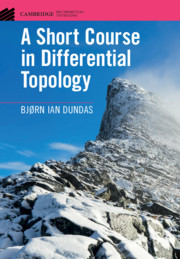'Learning some topics in mathematics is a bit like climbing a mountain - it is best done with a guide. In this short course, Dundas is just that guide - revealing the best routes, giving the reader first-hand experience through lots of well-chosen exercises, providing relevant and motivating examples, and finally, making it all fun.'
John McCleary - Vassar College, New York
'For such studies, the present book is excellent. It scores on a number of counts: It does a solid job on the big topics that launch the subject i.e., manifolds, the tangent space, the cotangent space - the usual suspects, as Claude Rains would have it (also of differential geometry) … The book starts with some marvelous and - at least to me - unexpected motivations, to wit, a discussion of how a robot’s arm operating in 3-space sweeps out surprising manifolds (like the torus), a discussion of the configuration space of a pair of electrons, and a discussion of state spaces and fibre bundles … You gotta love it. It looks like a very good book.'
Michael Berg
Source: MAA Reviews
'… the author has presented a wealth of important basic material of manifold theory … in a highly enlightening, inspiring and lucid manner. No doubt, this short introduction to the subject is even more than that, namely also a gripping guide through a fascinating area of contemporary mathematics. As such it may serve as an excellent introduction to the many more advanced textbooks in the literature on differential topology.'
Werner Kleinert
Source: zbMATH
'Summing up, the book is highly recommendable for all publics. An interested student can very well go through it quite by her/himself and learn a lot. A professor surely can discover useful aspects that may have skipped her/his attention before. But most important, Professor Dundas offers us a very enjoyable reading!'
Jesus M. Ruiz
Source: European Mathematical Society (www.euro-math-soc.eu)
‘... the author writes in a style that students will enjoy reading: the book is quite clear, chatty to the point of being colloquial ... and filled with helpful examples ... [It] serves beautifully as a first look at this material, and does a splendid job of preparing the reader for more sophisticated accounts of the subject.’
Mark Hunacek
Source: The Mathematical Gazette





